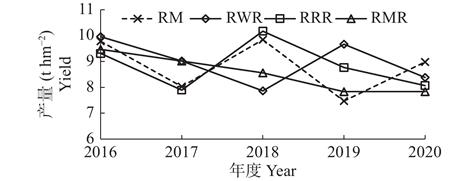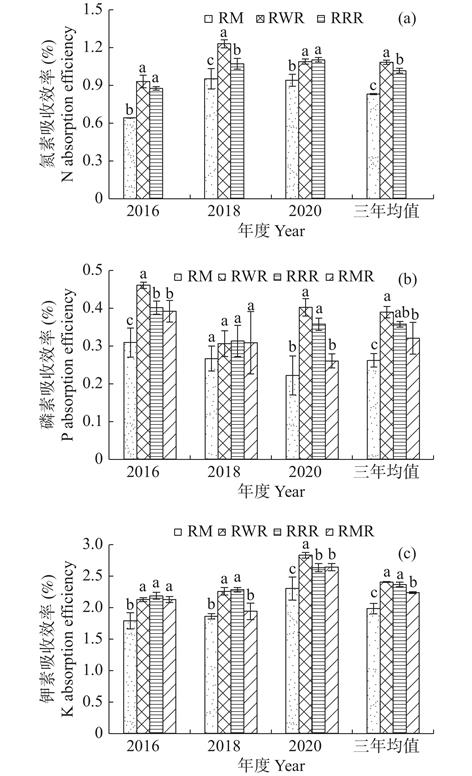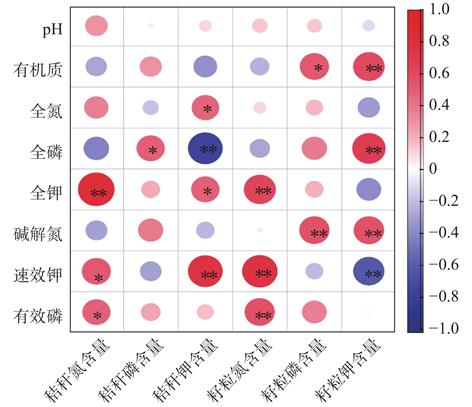| 小麦/玉米/大豆和小麦/玉米/甘薯套作体系中玉米产量及养分吸收的差异 |
| |
| 引用本文: | 左 琴, 刘彦伶, 李 渝, 黄兴成, 张雅蓉, 朱华清, 杨叶华, 熊 涵, 张文安, 蒋太明. 长期不同轮作方式对黄壤区水稻产量和养分吸收及土壤养分含量的影响[J]. 土壤通报, 2023, 54(4): 881 − 888. DOI: 10.19336/j.cnki.trtb.2022051001 |
| |
| 作者姓名: | 左琴 刘彦伶 李渝 黄兴成 张雅蓉 朱华清 杨叶华 熊涵 张文安 蒋太明 |
| |
| 作者单位: | 1.贵州大学农学院,贵州 贵阳 550025;2.贵州省农业科学院土壤肥料研究所,贵州 贵阳 550006;3.农业部贵州耕地保育与农业环境科学观测实验站,贵州 贵阳 550006;4.国家土壤质量贵阳观测实验站,贵州 贵阳 550006;5.贵州省农业科学院,贵州 贵阳 550006 |
| |
| 基金项目: | 国家自然科学基金(32060302)、黔农科院国基后补助[2021]52号、黔农科院科技创新[2022]09号、黔土肥技术[2022]8号、贵州省农业科学院青年科技基金项目(黔农科院青年基金[2022]20号)和贵州省科学技术基金(黔科合基础[2020]1Y411) |
| |
| 摘 要: | 
目的 探讨长期不同轮作方式与施肥条件下对水稻产量、植株养分吸收利用及对土壤养分含量的影响,为黄壤地区合理轮作方式选择提供参考。 方法 依托25年的黄壤(稻田)长期定位试验,选取4种轮作方式:水稻单作(RM)、水稻-小麦轮作(RWR)、水稻-油菜轮作(RRR)、水稻-绿肥轮作(RMR),分析比较各轮作方式作物产量、植株氮磷钾养分吸收情况及土壤养分含量的差异。 结果 不同轮作方式2016 ~ 2020年水稻平均产量表现为RWR > RRR > RM > RMR,但各处理之间差异不显著。与RM处理相比,RWR、RRR和RMR处理水稻秸秆和籽粒平均氮磷钾养分含量分别提高10.9% ~ 37.0%、63.6% ~ 101.6%、11.9% ~ 17.6%和7.1% ~ 20.4%、19.7% ~ 37.6%、6.0% ~ 8.1%;秸秆和籽粒平均氮磷钾养分吸收量分别提高15.0% ~ 45.4%、69.7% ~ 113.9%、16.1% ~ 24.8%和3.7% ~ 22.6%、15.9% ~ 40%、2.6% ~ 10.1%;水稻植株平均氮磷钾养分总吸收量分别提高8.0% ~ 30.2%、22.3% ~ 44.8%、12.9% ~ 21.3%。
各轮作处理水稻秸秆和籽粒氮磷钾养分含量、吸收量及吸收效率大小均表现为:RWR > RRR > RMR。与RM处理相比,各轮作处理土壤有机质提高37.0% ~ 41.1%、全氮提高1.7% ~ 28.6%、碱解氮提高24.4% ~ 47.5%、有效磷提高2.2% ~ 54.8%。 结论 在现有种植制度与施肥条件下,多种轮作方式均可维持水稻产量不降低,且能提高单位面积土地生产力、提高水稻植株氮磷钾养分吸收量、改善土壤肥力。

|
| 关 键 词: | 黄壤 长期轮作 水稻 养分吸收 土壤养分 |
| 收稿时间: | 2022-05-10 |
| 修稿时间: | 2022-06-20 |
|
| 点击此处可从《土壤通报》浏览原始摘要信息 |
|
点击此处可从《土壤通报》下载全文 |
|



